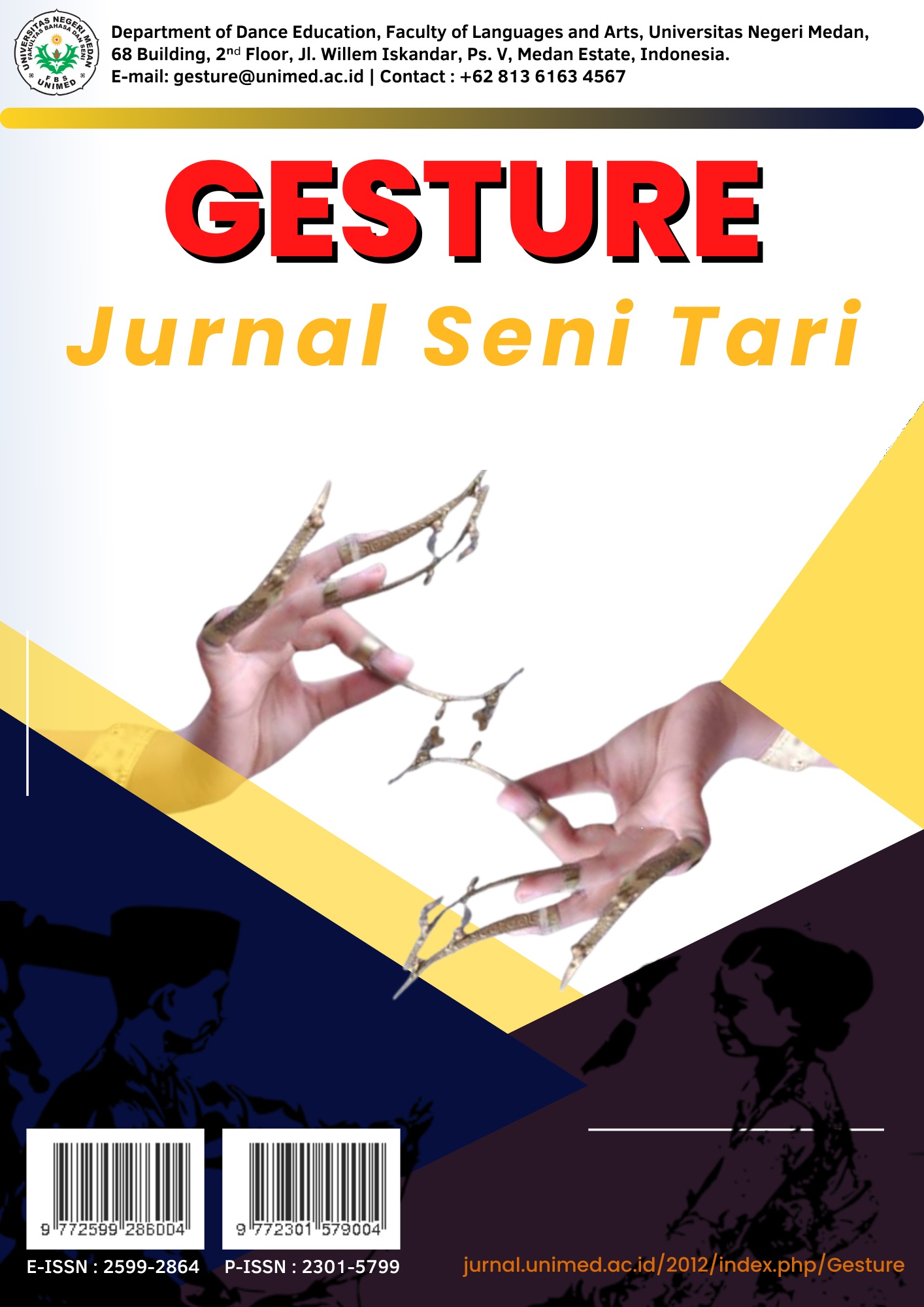Estetika Ragam Gerak dalam Tarian Kinyah Mandau Suku Dayak Ngaju Kalimantan Tengah
DOI:
https://doi.org/10.24114/gjst.v14i2.65915Abstract
The purpose of this study is so that readers can find out the aesthetics of the variety of movements in the Kinyah Mandau Dance of Central Kalimantan. The Kinyah Mandau Dance is a war dance originating from the Dayak Ngaju Tribe of Central Kalimantan. This dance depicts the unity and togetherness of the Dayak people in maintaining defense and security. In this study used a qualitative research method using a case study approach and literature study. The aesthetic values contained in the Kinyah Mandau dance movements refer to elements of beauty, courage, technique and agility of movement, visual side, philosophical value, and cultural expression. From the results of the study, there are several varieties of movements in the Kinyah Mandau Dance, namely the Tasai Manasai, Manangking Mandau, Mahunus Mandau and Menggigit Mandau movements. The Tasai Manasai movement is a graceful hand movement and footsteps that follow the rhythm of the music, the Manangking Mandau movement reflects the dancer's skill and dexterity in playing the Mandau weapon. The Mahunus Mandau movement requires precision in drawing (lifting) the weapon with the right technique and good coordination with the hands and body, and the Menggigit Mandau movement describes the agility of beauty in dancing by biting the Mandau.References
Damayanti, H. W., Sarjiwo, & Probosini, A. R. (2022). Nilai-Nilai Pendidikan Karakter pada Tari Sekar Pudyastuti dan Relevansinya dalam Pembelajaran Seni. Indonesian Journal of Performing Arts Education, 2(1), 20–26. https://doi.org/10.24821/ijopaed.v2i1.5543
Hidayat, V. A. (2020). Gerak Dan Rasa Dalam Tari Merak Jawa Barat. DESKOVI : Art and Design Journal, 3(2), 104. https://doi.org/10.51804/deskovi.v3i2.804
Maisyarah, R., & Prativi, M. (2023). Keharmonisan Pada Gerak Tari Saman Dalam Perspektif Estetika. Human Art'sthetic Journal, 1(1), 15-22. https://id.scribd.com/document/766323643/848
Murcahyanto, H., Imtihan, Y., Yuliatin, R. R., & Mahyumi, H. S. (2020). Bentuk Dan Elemen Gerak Tari Dayang-Dayang. Kaganga:Jurnal Pendidikan Sejarah dan Riset Sosial Humaniora, 3(2), 70–80. https://doi.org/10.31539/kaganga.v3i2.1374
Nugraheni, E. Y., & Safarina, V. (2018). Makna Tari Kinyah Mandau Hatue Suku Dayak Kabupaten Kapuas, Kalimantan Tengah. 7, 35–53. https://journal.unair.ac.id/download-fullpapers-bk924d942098full.pdf
Pratiwi, A. S., Respati, R., & Giyartini, R. (2020). Tari Egrang Batok di Sekolah Dasar. PEDADIDAKTIKA: Jurnal Ilmiah Pendidikan Guru Sekolah Dasar, 7(3), 257–266. https://doi.org/10.17509/pedadidaktika.v7i3.26195
Raji, F., Rahmani, & Surwajiya. (2023). Unsur-Unsur Kebudayaan Dalam Tari Tradisi Kanjan Halu Di Sanggar Tari Tingang Menteng Pahunjung Tarung Kabupaten Kapuas. TANDIK: Jurnal Seni dan Pendidikan Seni, 2(2), 134–148. https://doi.org/10.33654/tdk.v2i2.1890
Rico, R., Susanto, D., Fatimah, S., & Adawiyah, M. (2024). Peran Tari Mandau Suku Dayak Dalam Komunikasi Budaya Di Era Modern: The Role Of The Dayak Mandau Dance In Cultural Communication In The Modern Era. Anterior Jurnal, 23(2), 96–105. https://doi.org/10.33084/anterior.v23i2.6979
Rochayati, R. (2020). Tari Kipas Chandani: Gerak, Ruang, Dan Waktu. GETER : Jurnal Seni Drama, Tari dan Musik, 3(2), 12–25. https://doi.org/10.26740/geter.v3n2.p12-25
Rochayati, R., & Hera, T. (2019). Estetika Tari Melaju Dengan Mutu. Jurnal Sitakara, 4(2), 21–29. https://doi.org/10.31851/sitakara.v4i2.3253
Rosalince, A. (2022). Estetika Kancet Lasan Suku Dayak Kenyah Lepoq Tau Di Desa Rukun Damai Kabupaten Mahakam Ulu Provinsi Kalimantan Timur (Doctoral dissertation, Institut Seni Indonesia Yogyakarta). http://digilib.isi.ac.id/12136/
Sagiarlie. (2025, Maret 5). Guru Seni Budaya di SMAN 1 Manuhing [Komunikasi pribadi].
Tristiani, V. D., & Lanjari, R. (2019). Nilai Estetika Tari Gambang Semarang pada Komunitas Gambang Semarang Art Company. 2, 198–204. https://journal.unnes.ac.id/sju/jst/article/view/35180
Wisra, O., & Mayar, F. (2020). Pembelajaran Seni Tari Terhadap Perkembangan Fisik Motorik Anak Usia Dini. Ensiklopedia of Journal, 2(2), 20-27. https://doi.org/10.33559/eoj.v2i2.386
Yuwono, B. T. (2022). Mandau sebagai Identitas Budaya Suku Dayak (Borneo, Indonesia). Memetika: Jurnal Kajian Budaya, 4(2), 58-68. https://doi.org/10.20961/mjkb.v4i2.79260
Downloads
Published
Issue
Section
License
Copyright (c) 2025 Ripaldo Ripaldo, Dyas Defa

This work is licensed under a Creative Commons Attribution-ShareAlike 4.0 International License.
Authors published with the Gesture: Jurnal Seni Tari agree to the following terms:
- Authors retain copyright and grant the journal the right of first publication with the work simultaneously licensed under a Creative Commons Attribution License (CC BY-SA 4.0) that allows others to share the work with an acknowledgment of the work's authorship and initial publication in this journal.
- Authors are able to enter into separate, additional contractual arrangements for the non-exclusive distribution of the journal's published version of the work (e.g., post it to an institutional repository or publish it in a book), with an acknowledgment of its initial publication in this journal.
- Authors are permitted and encouraged to post their work online (e.g., in institutional repositories or on their website) prior to and during the submission process, as it can lead to productive exchanges, as well as earlier and greater citation of published work. (See The Effect of Open Access)








